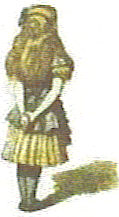As Alice learned, it's not always clear what's a looking glass, and what's a window to another world. Mirrors and windows are often interchangeable: we look out into the world, and see ourselves reflected back. We look at a reflection, and believe it's showing us a world beyond. We internalize the mirror image and project the one inside. Objects, actions and ideas can become so confused with their reflections that it's impossible to untangle them. What's phantom and what's real? Is there even a relevant difference?

I am always taken back to Thomas Young's experiments and where the photon has travelled, while we see the resulting evidence of it's travel on the screen.
Welcome to the mirror world, in which every particle in the known universe could have a counterpart. This cosmos would hold mirror planets, mirror stars, and even mirror life.
Have they found more dramatic ways in which to see these travels? Most certainly? Were these methods steep in metaphysical ways in which the mind saw fit to think that indeed there were other worlds?
Developed by Feynman to decribe the interactions in quantum electrodynamics (QED), the diagrams have found use in describing a variety of particle interactions. They are spacetime diagrams, ct vs x. The time axis points upward and the space axis to the right. (Particle physicists often reverse that orientation.) Particles are represented by lines with arrows to denote the direction of their travel, with antiparticles having their arrows reversed. Virtual particles are represented by wavy or broken lines and have no arrows. All electromagnetic interactions can be described with combinations of primitive diagrams like this one
Before, we were tantalized with fictional stores about "other worlds" and the fiction of Lewis Carroll. INsanely driven, by such fictions, there were concerted efforts to experimentally challenge what the little photon was doing. Thus forward, the little photon became known as Alice in experiment?
Fast forward now, and with all this new experimental knowledge of science that we are now governed by the principles of what happens at the time of such creations, that the "spectrum" becomes the basis for what happens at any beginning? The journey "through" identifying "particulars of materials," as we now know their signatures.
In its quest for the quark-gluon plasma, a state of matter that is believed to have existed just after the Big Bang, ALICE will use a very accurate tracker system. The major part of this system is the time projection chamber (TPC), wherein the trajectories of electrically charged particles are reconstructed and their identity is determined. The ALICE TPC, a cylinder of 5 metres in diameter and 5 metres in length, is the largest of its kind worldwide. Nearly completed, it now has all read-out chambers installed with the custom electronics complete for the approximately 560000 read-out channels.
Did you know?
In a time projection chamber (TPC), an electric field is applied across a large volume of gas. When a charged particle traverses the TPC, it ionizes the gas and the liberated electrons drift in the electrical field to the endplates. The position on the endplate gives two coordinates. The third is given by the time of arrival of the electrons- hence the name of time projection chamber.
Thus what sense if one can not be taken to the level of supersymmetry where the superfluid provides for a channel/tunnel through which "unaccountable energy is lost" as well as engage the wonder "similarily" as we looked early on at what the photon was doing?
So there is this relationship to the energy, as we look at "point sources" and what GR encompasses not only from a cosmological standpoint, but from how we see the events wrapped in the wonders of the message Higgins will give us about the nature of such gatherings? So "Higgins" resides on the outside/inside of the balloon?
We know that the graviton is not held to "such events" as Alice is? We know Higgins travels beyond the standard model, beyond 3+1 in ideas about a Professor crossing the room?
I would like you to meet "Higgins" the graviton. :)
The search for supersymmetry, or other physics beyond the Standard Model (SM) is becoming ever more tantalizing. The idea that the SM is theoretically incomplete is an old one. There is now a whole range of innovative and experimentally striking suggestions for this new physics that underlies the SM. A recent conference at CERN, Supersymmetry 2000, surveyed the scene.

No comments:
Post a Comment